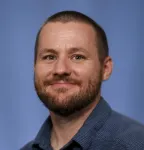(Press-News.org) Arthritis affects various joints differently, despite systemic inflammatory cues.2 In people with rheumatoid arthritis, transcriptomic variances identified in synovial fibroblasts from various joint sites have been shown to translate into joint-specific phenotypes with distinct characteristics and responsiveness to cytokines.2,3 These findings suggest that different joints may potentially respond variably to specific immunosuppressive treatments. To expand on this, Ciurea and colleagues set out to investigate whether joints at different anatomical locations in people with PsA might respond differently to treatment with a tumour necrosis factor inhibitor (TNFi). The results have been released in an abstract at the 2024 EULAR congress in Vienna.
The research was based on real-life data from several European registries collaborating in the EuroSpA network – and over 1,700 PsA patients starting a first TNFi. The primary outcome was time to first resolution of joint swelling on an individual joint level based on the 28-joint count, assessed at baseline and at various timepoints over 2 years.
At baseline, the mean number of swollen and tender joints at baseline was 4.8 and 7.4, respectively, with a mean disease activity score using the C-reactive protein (DAS28-CRP) of 4.7. When looking at joints of the upper limb – with the proximal interphalangeal joint of the third digit (PIP3) as a reference – a significantly higher rate of resolution of joint swelling was observed for the elbow and the shoulder. In contrast, a lower rate of resolution of joint swelling was found for the wrist in relation to the PIP3 joint. However, there was no evidence for a difference in resolution of joint swelling in the knee as compared to the elbow.
The results suggest that the clinical response to a TNFi in PsA appears to depend on joint location – at least in terms of time to the first resolution of joint swelling. This approach also indirectly identified those joints that were less likely to resolve despite TNFi treatment, suggesting that local factors might impact treatment effectiveness at specific joints – such as mechanical factors or specific synovial fibroblast phenotypes. This new work suggests a need for future analyses to explore whether joint-specific responses in PsA are associated with distinct therapeutic modes of action.
Source
Ciurea A, et al. Differential joint-level responses to TNF inhibitors in psoriatic arthritis: A collaborative European observational cohort study. Presented at EULAR 2024; OP0034.
Ann Rheum Dis 2024; DOI: 10.1136/annrheumdis-2024-eular.2535.
References
1. Gossec L, et al. EULAR recommendations for the management of psoriatic arthritis with pharmacological therapies: 2023 update. Ann Rheum Dis 2024; DOI: 10.1136/ard-2024-225531.
2. Frank-Bertoncelj M, et al. Epigenetically-driven anatomical diversity of synovial fibroblasts guides joint-specific fibroblast functions. Nat Commun 2017;8:14852.
3. Elhai M, et al. The long non-coding RNA HOTAIR contributes to joint-specific gene expression in rheumatoid arthritis. Nat Commun 2023;14:8172.
About EULAR
EULAR is the European umbrella organisation representing scientific societies, health professional associations and organisations for people with rheumatic and musculoskeletal diseases (RMDs). EULAR aims to reduce the impact of RMDs on individuals and society, as well as improve RMD treatments, prevention, and rehabilitation. To this end, EULAR fosters excellence in rheumatology education and research, promotes the translation of research advances into daily care, and advocates for the recognition of the needs of those living with RMDs by EU institutions.
Contact
EULAR Communications, communications@eular.org
Notes to Editors
EULAR Recommendations
EULAR School of Rheumatology
EULAR Press Releases
END
Location, location, location – does it matter in psoriatic arthritis?
Exploring whether different joints have different treatment outcomes
2024-06-12
ELSE PRESS RELEASES FROM THIS DATE:
Stopping the march
2024-06-12
The estimated prevalence of psoriatic arthritis (PsA) in people with psoriasis ranges widely –between 6% and 42% – but in most cases, skin symptoms precede PsA, thus making skin psoriasis a model for pre-PsA.2 Assuming that there are shared pathways in the pathogenesis, it is possible that stringent treatment of moderate-to-severe psoriasis could reduce progression to clinically overt PsA.3,4 Biologic treatments are effective at controlling psoriasis, but there are no conclusive data that these treatments help prevent people from developing PsA. Several risk factors for transition have previously been identified by a EULAR taskforce.5 ...
Predicting response in treatment-naïve RA
2024-06-12
The synovial tissue inflammation seen in RA shows high degree of heterogeneity – which may be a factor in people’s variable response to treatments. We also know that distinct synovial tissue macrophage subsets regulate inflammation and remission in rheumatoid arthritis.1 The potential of high-throughput analyses has been shown, and these technologies can help dissect disease heterogeneity and identify novel biomarkers that could be used in prognosis.2
To explore this further, 373 treatment-naïve RA patients were enrolled and given an ultrasound-guided synovial tissue biopsy. The synovitis degree and synovial pathotype was then determined for ...
Testing the systemic score for Still’s disease
2024-06-12
A multi-centre, observational, prospective study was designed to evaluate the clinical usefulness of the systemic score in predicting life-threatening evolution – defined as the development of macrophage activation syndrome (MAS) and/or mortality. The intention was also to derive a more aggressive clinical patient subset. To achieve this, Ruscitti and colleagues collected data from 597 patients taking part in the GIRRCS (Gruppo Italiano Di Ricerca in Reumatologia Clinica e Sperimentale) AOSD-study ...
Early RA: Disease trajectories and pain
2024-06-12
The 2024 EULAR congress in Vienna included a clinical abstract session focusing on pain and prognosis in RA, where two groups presented their research into ways to characterise early RA.
The first looked at dissecting early RA patient trajectories through time-independent disease state patterns of inflammation in blood or joints. Presenting the work, Nils Steinz said “Previous studies have identified smooth time trajectories of rapid, slow, or no progression of disease activity, assessed through DAS28. In real life, we observe more chaotic disease evolvements – and particularly the detours could ...
Testing the thresholds
2024-06-12
However, this recommendation is not always followed in practice. This could be because the ASDAS was developed for research, and it is not known how well it performs in daily practice. Possibly, the cut-off of 2.1 as currently endorsed may be too strict in an everyday setting. To address this, Webers and colleagues set out to investigate which ASDAS cut-off values correspond best with treatment intensification in practice.
Data were taken from a prospective multi-centre registry for SpA, and treatment ...
Ingestible microbiome sampling pill technology advances
2024-06-12
Significant progress has been made at Tufts University School of Engineering in the development of a small device, about the size of a vitamin pill, that can be swallowed and passed through the gastrointestinal tract to sample the full inventory of microorganisms in an individual’s gastro-intestinal tract. This device has the potential to advance research on the relationship between resident bacteria and a wide range of health conditions. It could also serve as a diagnostic tool for adjusting the microbiome or administering drugs to treat those conditions.
The device has completed ...
Just thinking about a location activates mental maps in the brain
2024-06-12
As you travel your usual route to work or the grocery store, your brain engages cognitive maps stored in your hippocampus and entorhinal cortex. These maps store information about paths you have taken and locations you have been to before, so you can navigate whenever you go there.
New research from MIT has found that such mental maps also are created and activated when you merely think about sequences of experiences, in the absence of any physical movement or sensory input. In an animal study, the researchers found that the entorhinal cortex harbors a cognitive map of what animals experience while they use a joystick to browse through a sequence of images. ...
Obesity-cancer connection discovery suggests strategies for improving immunotherapy
2024-06-12
Immune system cells called macrophages play an unexpected role in the complicated connection between obesity and cancer, a Vanderbilt University Medical Center-led research team has discovered.
Obesity increases the frequency of macrophages in tumors and induces their expression of the immune checkpoint protein PD-1 — a target of cancer immunotherapies. The findings, published June 12 in the journal Nature, provide a mechanistic explanation for how obesity can contribute to both increased cancer ...
Smartwatches offer window into Parkinson's disease progression
2024-06-12
Ubiquitous wearable technologies, like smartwatches, could help researchers better understand progressive neurological disorders like Parkinson’s disease and speed up the approval of new therapies, a critical need given that no drugs exist to slow progression of the world’s fastest growing brain disease.
New research appearing today in the journal njp Parkinson’s Disease adds to growing evidence that widely used and user-friendly consumer devices, in this instance an Apple Watch paired with an iPhone, ...
What the geologic record reveals about how oceans were oxygenated 2.3 billion years ago
2024-06-12
About 2.5 billion years ago, free oxygen, or O2, first started to accumulate to meaningful levels in Earth’s atmosphere, setting the stage for the rise of complex life on our evolving planet.
Scientists refers to this phenomenon as the Great Oxidation Event, or GOE for short. But the initial accumulation of O2 on Earth was not nearly as straightforward as that moniker suggests, according to new research led by a University of Utah geochemist.
This “event” lasted at least 200 million years. And tracking the accumulation of O2 in the oceans has been very difficult until now, ...
LAST 30 PRESS RELEASES:
Tunnel resilience models unveiled to aid post-earthquake recovery
Satellite communication systems: the future of 5G/6G connectivity
Space computing power networks: a new frontier for satellite technologies
Experiments advance potential of protein that makes hydrogen sulfide as a therapeutic target for Alzheimer’s disease
Examining private equity’s role in fertility care
Current Molecular Pharmacology achieves a landmark: real-time CiteScore advances to 7.2
Skeletal muscle epigenetic clocks developed using postmortem tissue from an Asian population
Estimating unemployment rates with social media data
Climate policies can backfire by eroding “green” values, study finds
Too much screen time too soon? A*STAR study links infant screen exposure to brain changes and teen anxiety
Global psychiatry mourns Professor Dan Stein, visionary who transformed mental health science across Africa and beyond
KIST develops eco-friendly palladium recovery technology to safeguard resource security
Statins significantly reduce mortality risk for adults with diabetes, regardless of cardiovascular risk
Brain immune cells may drive more damage in females than males with Alzheimer’s
Evidence-based recommendations empower clinicians to manage epilepsy in pregnancy
Fungus turns bark beetles’ defenses against them
There are new antivirals being tested for herpesviruses. Scientists now know how they work
CDI scientist, colleagues author review of global burden of fungus Candida auris
How does stroke influence speech comprehension?
B cells transiently unlock their plasticity, risking lymphoma development
Advanced AI dodel predicts spoken language outcomes in deaf children after cochlear implants
Multimodal imaging-based cerebral blood flow prediction model development in simulated microgravity
Accelerated streaming subgraph matching framework is faster, more robust, and scalable
Gestational diabetes rose every year in the US since 2016
OHSU researchers find breast cancer drug boosts leukemia treatment
Fear and medical misinformation regarding risk of progression or recurrence among patients with breast cancer
Glucagonlike peptide-1 receptor agonists and asthma risk in adolescents with obesity
Reviving dormant immunity: Millimeter waves reprogram the immunosuppressive microenvironment to potentiate immunotherapy without obvious side effects
Safety decision-making for autonomous vehicles integrating passenger physiological states by fNIRS
Fires could emit more air pollution than previously estimated
[Press-News.org] Location, location, location – does it matter in psoriatic arthritis?Exploring whether different joints have different treatment outcomes


